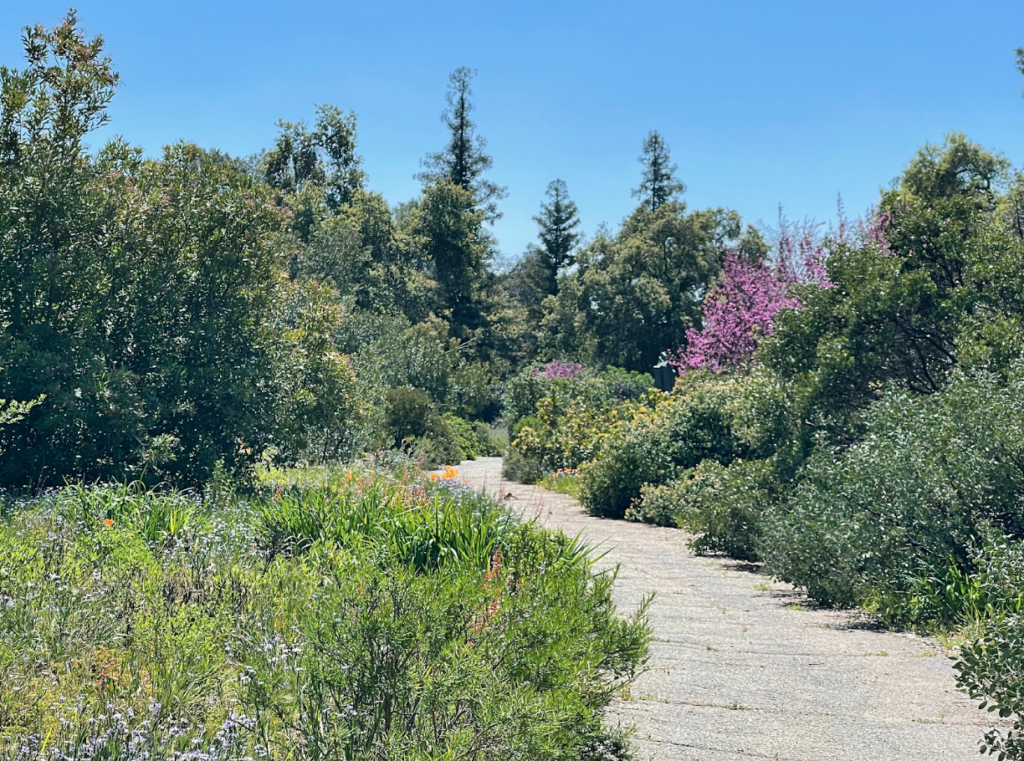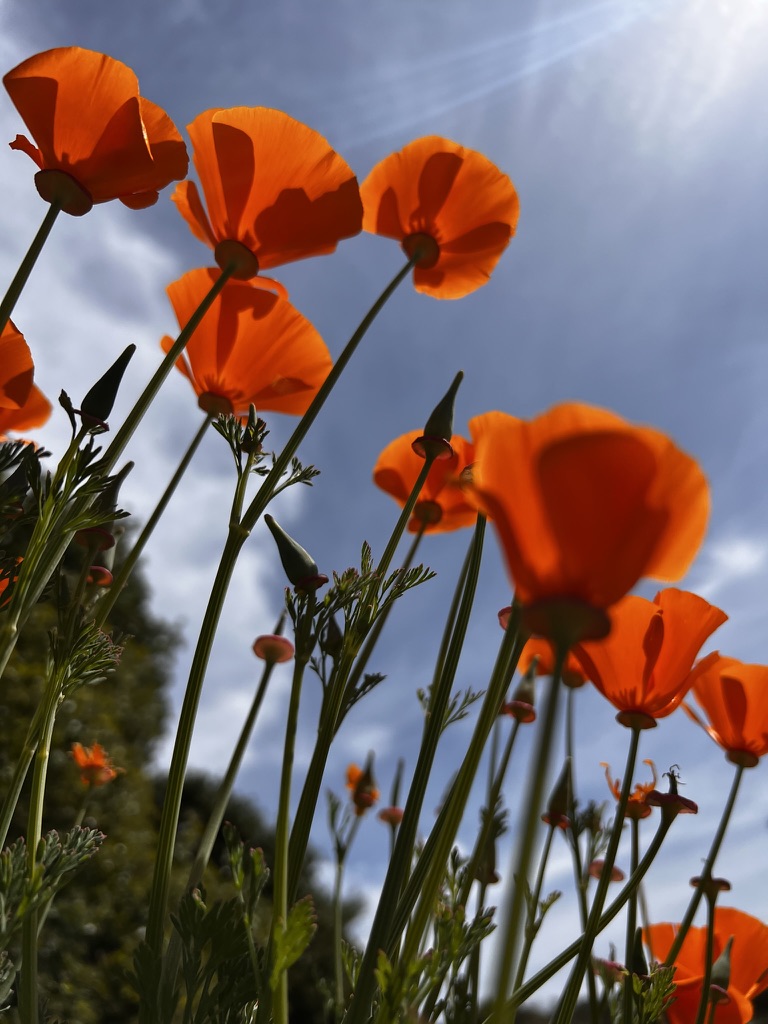
One of the best years for native plants in memory, and perhaps for some, the best year ever! We have 24.51 inches for the season total to date at Tree of Life. Many places in the foothills and the coast near Santa Barbara are looking at 35 inches – an amount practically unheard of. All the streams are running and should continue a good long time as the abundant snow starts to melt. Plants are absolutely loving it, and so are plant people.
Current events, history, review, and notes
We’re seeing the sun come out, and stay up for a nice day length, each day progressing towards the longest day at the solstice in June. We may see a few cloudy days, and even a couple more showers this month, but for the most part the spring sunshine will be doing its work on our rain soaked gardens… and this will be fantastic!
April is a fun month with lots of garden activities available. Read on, and… sorry for the rather long newsletter this month!
Our driveway
Watering
This will be easy. Established natural gardens will require no irrigation this month. During heat spells, young plants and flowering annuals may benefit from a quick Refreshing Sprinkle, and with brand new plants (just planted) always make sure the root ball does not dry out, even if the surrounding soil is moist.
Related to Watering
Watch for “midday depression,” especially on flowering annuals and the tender new growth on subshrubs (i.e.; salvia) and shrubs (i.e.; ceanothus). This is an agricultural term for the wilt that happens on healthy new growth, during the period when direct sun hits the plant, especially on plants growing in the shade. The sun is getting higher in the sky, hitting new areas of the shade garden.
Midday depression happens in nature, farm fields, and gardens. At first, you might guess that the soil is dry, but this early in the season, and with so much tender new growth this year, it is likely that the plant simply can’t transport water fast enough from the roots to the branch tips, causing wilt. Check the same plant a couple hours later, when the midday sun has passed and the shade is back… and certainly by evening, the plant will not be wilted. That’s midday depression. I think I get that sometimes too. Also, if the plant stays wilted, check the soil. You may have a dry spot.
Pruning
This is a great month to do any kind of pruning you like, in order to give the plants a better shape or a second fresh start before we head into pre-summer and summer. There are basically three types of pruning; thinning, heading back, and shaping. Of course you can also include a fourth, corrective pruning, which is when you remove diseased, damaged, duplicate, down-heading, or dead branches.
Be careful not to prune off flower buds from salvia, buckwheat, sunflower, etc.. Manzanitas almost never need heading back or shaping, but a little thinning will reveal their beautiful branches. Ceanothus should be headed back and shaped when they finish flowering in the next few weeks. Lemonade berry can actually be hedge pruned if that’s what you desire. Toyon should basically be left alone except to maybe give it a nice shape with some very light thinning. Same with coffeeberry. Best not to prune these at all, though they can take thinning, heading back and shaping.
“Pinching” is an almost invisible technique where you remove about 1/4 – 1/2” from a branch tip, with your fingers. Simply pinch off the tiny tender bud. This encourages all the side branches to grow and basically keeps the plant bushier. This is the season, and you can pinch to your heart’s content. It makes for healthy branches instead of long gangly ones that would need more severe pruning later.
Always approach any pruning job slowly and carefully, Try to determine your goal ahead; removal of 10%, 20%, more? (Not too much more). Take a little, stand back, look at your work, take a little more, stand back. Know when to stop. You can take more off, but you can never put it back on.
Always sanitize your tools with a periodic dip in a 10% bleach solution, alcohol, or with Lysol spray. We keep a little coffee can with bleach solution at hand for every pruning task. This prevents the potential spreading of disease.
Don’t hesitate to write to me with specific questions on pruning. Send pictures.
Weeding
With the exuberant plant growth we also get a healthy weed crop. I’m seeing a lot of weedy grasses this year. Whether broadleaf or grass, weeds are growing really fast and they can get out of hand very quickly. Whether you pull, hoe, or mow, stay on task to prevent the weeds from going to seed. This is one chore we all wish we could live without, but I find if I just put my mind in neutral and set a certain time limit, I can get a lot done. I usually go past my time limit anyway, so it’s really just a mind game that helps me get started.
Mulching / Top Dress
If you have been reading this monthly newsletter very long, you’ve found that we advocate for the natural accumulation of leaves under each shrub to build up as a natural “top dress.” We also like mineral mulches in southern California natural gardens depicting local chaparral habitats. Organic mulch or top dress, if brought in from off site, should mimic or compliment the natural mulch for the plant community and narrative in that section of your garden. In other words, the top dress is part of your story, your design, as well as a contributor to the overall health of your soil and plants. So choose your mulch carefully.
As we come to the end of our rainy season, it is safe to bring organic or mineral top dress onto the surface of your garden soil… if there is a need… to complete a design theme and/or to preserve soil moisture and discourage weeds. Organic mulch should be chunky (i.e. bark products, not chipped wood). Remember, the worst mulch is one that contains all of the following: sticks, flakes, dust, and strings. It will lock in on itself and form a mat impenetrable to air and water, therefore suffocating or waterlogging your soil. Look for a mulch that looks nice and “breathes,” allowing water to pass through and air to follow the water down into the soil.
Apply organic top dress approximately 1 – 2” thick. Apply mineral top dress, decomposed granite, aggregates, small stones, or a combination, approximately 1” thick.
Do not allow any top dress to be gathered or mounded around the plant’s collar, that is the stem where the branches meet the roots.
Feeding
April and May are ideal months to apply an all purpose, organic, granular (dry) fertilizer to the soil surface. Simply scatter it about, following the instructions on the bag (for natives, you can actually cut the rate by about half), and scratch it into the top half inch of soil with a three-prong cultivator, or similar tool. The fertilizer will start breaking down the humus on the surface and will later penetrate deep into the root zone soil with rains and irrigations to come.
Troubleshooting – Varmints, Pests and Diseases
Springtime brings life to the garden including a few garden pests. If it’s aphids that are bothering you, just cup the branch tip in the palm of one hand, and blast ‘em to smithereens with a strong spray of water from a pistol-grip hose nozzle. Watch for other insects as we get into longer days and drier weather. Of course, in a good natural garden, you will always have a perfect balance including beneficial pollinators and predators.
Annual Wildflowers
If you want the last acts of showtime, and the potential for on-site seed set for next year, we still have some annuals in pots for you, in bloom even! Come on by.

Adding New Plants
We are still in the perfect season for planting natives. Enough said. We have a wonderful selection of beautiful plants. Enough said. Come on by. Thank you.
Phytophilia
This month plants are simply basking in their glory. A few days ago, I took a group to California Botanic Garden in Claremont. Everything is looking great, and with the snow-laden mountains as a backdrop on a perfect sunny day, we got some nice shots. The plants were telling me they’re happy with all the attention. Day after day, so many people stopped in their tracks to stare and photograph. It’s as if the plants are showing off for us.
Important Review
Lots of rain (Duh!)
No need to water
Midday depression can trick you
Pruning yes
Weeding yes
Mulching / Top dress ok
Feeding yes
Create an ecological balance with garden allies in charge of plant pests
Plant flowers and other natives yes
Plants are showing off (again, but it’s been a long time so we’re happy to watch them)
So, there’s a lot that can be done, and a full list of garden activities (except watering)
“Be” (see below)
Engage
In this section we talk about our reciprocal relationship with our gardens.
Last month I attended a presentation by Dr. Sue Stuart-Smith called “The Well-Gardened Mind.” The Garden Conservancy brought Dr. Stuart-Smith from England to speak in a national lecture series with only two venues on the west coast, this one at The Ebell of Los Angeles, the other at Filoli in Woodside. I feel fortunate to have experienced this. Her comments were profound, and I will be ordering her book. Here’s a link to a similar talk she gave at Stanford a couple years ago:
The Well-gardened Mind: The Restorative Power of Nature with Sue Stuart-Smith
And here are a few lines from my quickly scribbled notes that day:
Gardening is a quintessentially creative activity
Lost in play
The idea of “care” has become undervalued in our society
“Caring” can be draining, but not with gardens, because they give back
Plants are non threatening
Pleasure, calmness, mood boost
Temporal, in the moment
Association with the past, memories
Imaginative, appealing to the spiritual side of life
Spatial, enclosed without entrapment, safe, then open to the sky
A garden is a place where people can simply “be”
“Be” in nature, people can reconnect with their bodies and with their senses
We balance “being” and “doing” in our time spent in the garden
Freud: “Flowers are restful to look at. They involve neither emotions nor conflict.”
The transience of life, no denying things die
The continuity of life, the seasons, etc.
Beauty is a form of nourishment
We become one with the beautiful thing
A little bit of novelty every day
A sense of shared experience, topic of conversation, sense of accomplishment
Multicultural – the “language” of plants
Prosocial effects of gardens, building a social bridge
Beauty activates our emotional centers
Wonderful, right?
(I want to thank Catherine and Robert Waters for telling me about this lecture and riding up to LA with me.)
Natural gardens make small places look big because they remind us of really big places.
Hey, it’s spring and we made it. I mean we really made it!
From the APRIL Natural Garden,
Mike Evans
Questions? Help is just one call or one email away. Call (949) 728-0685 or email (with pictures if you like) our special helpline: gardenhelp@californianativeplants.com